Exploring the Wonders of CERN: A Journey into Science
Written on
Chapter 1: Introduction to CERN
CERN, the European Organization for Nuclear Research, is often regarded as one of the most intriguing scientific establishments in the world. It is here that the World Wide Web first came to life, a fact I learned during my visit to this iconic site in Switzerland.
Last year, my family had the privilege of traveling to Switzerland, and I seized the chance to explore CERN, the epicenter of scientific innovation. If you're fortunate, you can schedule a visit, as select employees and scientists volunteer to guide tours for those lucky enough to secure a spot. Registration typically opens a few weeks in advance and fills up in mere seconds—reminiscent of trying to snag tickets to a popular concert. However, if you miss out on a guided tour, don’t despair; CERN also boasts several museums accessible to the public.
Currently, due to the ongoing impact of the COVID-19 pandemic, public visits are suspended, but updates on future tours in both French and English can be found on their official website.
Section 1.1: A Brief History of CERN
Following the devastation of World War II, Europe found itself in dire straits, struggling to regain its scientific stature. In response, a proposal arose during a meeting of scientists and political leaders to create a European laboratory dedicated to nuclear research. This initiative eventually led to the establishment of CERN, which has consistently focused on fostering collaboration among physicists from Europe and beyond, without military intentions.
The significance of CERN cannot be overstated; it is a hub of scientific brilliance, where the Web was born. Today, approximately 17,000 scientists from over 100 countries collaborate with CERN, with only a few thousand employees stationed in Geneva to maintain facilities like the Large Hadron Collider and various data centers. Most of the scientific community operates from their home countries, utilizing the data CERN provides for their research endeavors.
Subsection 1.1.1: The Large Hadron Collider
CERN is home to the Large Hadron Collider (LHC), the world's most powerful particle accelerator. This remarkable machine spans 27 kilometers underground and features superconducting magnets and accelerating structures designed to propel particles at nearly the speed of light. When these particles collide, detectors capture the resulting chaos, revealing countless new particles born from the collision.
To illustrate this, our guide likened it to two watermelons crashing together, creating a mess that helps us understand their original shapes. The LHC aims to recreate conditions reminiscent of the Big Bang, allowing scientists to analyze data from these collisions and hopefully uncover yet-to-be-discovered particles that could shed light on the origins of our universe.
Explore the depths of CERN and understand what's truly happening at this groundbreaking facility.
Section 1.2: The Higgs Boson and Nobel Prize Recognition
During our tour, we learned that many scientists at CERN aspire to win a Nobel Prize. A notable achievement occurred in 2013, when Drs. Peter Higgs and François Englert were awarded for their independent theoretical predictions regarding the Higgs boson and the Higgs mechanism. The discovery of the Higgs boson particle provided insights into the existence of the Higgs field, an invisible energy source that endows particles with mass—crucial for understanding how the universe's first particles gained mass shortly after the Big Bang.
In 2012, CERN announced the identification of the Higgs boson after extensive experiments with the LHC, confirming Higgs's and Englert's theories and earning them prestigious recognition.
Chapter 2: The Birth of the Internet
Another brilliant mind associated with CERN is Tim Berners-Lee, a British scientist who played a pivotal role in developing the Internet. Decades ago, while at CERN, he proposed a system for automating information-sharing among scientists globally through "hypertext documents" accessible via "browsers." Initially met with skepticism, his vision was later embraced and transformed into a revolutionary tool for communication.

Berners-Lee chose not to patent his invention, believing it would accelerate global development and serve humanity. To this day, he advocates for a free and open Internet, striving to protect it from monopolistic influences and misuse.
For those eager to learn more about CERN, I highly recommend visiting their website, which is rich with videos, articles, and resources that delve into the fascinating aspects of their work.